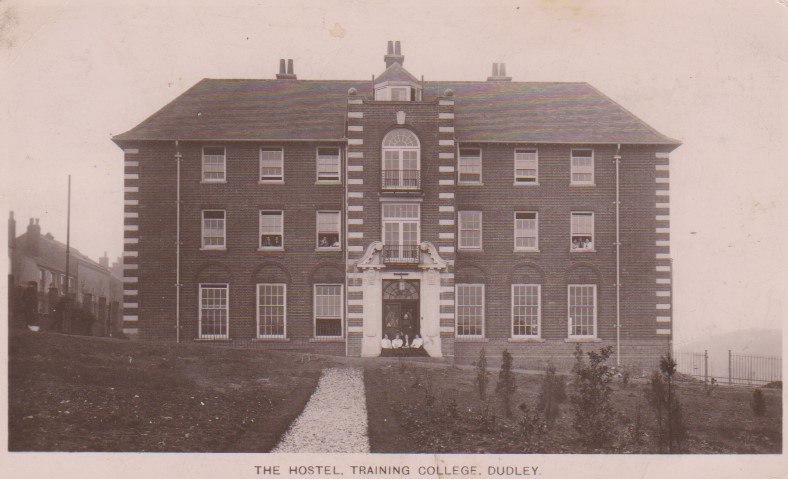Dudley Training College for Teachers
(Last updated 16/2/2021)
After leaving Castleford Secondary School in the summer of 1930 J.L. Carr spent a year working for £1 a week as a supernumerary teacher in a school at South Milford, the village next to Sherburn-in-Elmet, while he tried to get admission to a teacher training college. He was accepted by a college situated in the small town of Dudley, between Birmingham and Wolverhampton, then in an exclave of Worcestershire. He started to study there in September 1931. The letterhead paper which Carr sometimes used to write to his parents when he was a student at Dudley bears the name and address Dudley Training College for Teachers, Castle View, Dudley, Worcestershire. There is also a postcard written by Carr with a picture of this institution on the front, a grand Edwardian building (see below).

The main building of Dudley Training College for Men and Women Teachers, built in 1908, demolished in 2002.
The short life of this substantial building is quite odd. According to an article in The Black Country Bugle on 29th April 2004, the College was built on 8 acres of land on Eve Hill bought by the County Borough of Dudley in 1908 from the Earl of Dudley for £8,000, which is equivalent to about £820,000 in 2018. The main college building was designed by a firm of architects called Crouch, Butler & Savage and was built at a cost of £10,799. It was opened on 16th July 1909 by the President of the Board of Education, Walter Runciman. The site of the new college faced King Edmund Street and the entrance was reached up Castle View, which is about a kilometre from Dudley Castle and has no view of it.
To be admitted as a student an applicant must have been 18 years of age on 1st August in the year of admission. The applicant must have passed a First Examination for Secondary Schools or some other approved Examination of at least equivalent standard, and must have passed a medical examination after being provisionally accepted. Candidates without prior experience of teaching needed to apply to their local Education Authority for permission to spend a minimum period of two weeks in an Elementary School for observation and teaching practice. Carr had been teaching for a year, so this requirement was easily satisfied. He was 19 years old in September 1931.
There were two students' hostels, the North Hostel and The Mount. The North Hostel (see left) provided accommodation for 50 female students and was situated within the college grounds. The Mount accommodated 21 male students and was some distance from the College, at Dixon's Green. Male students who were unable to live at home or in the Hostel, lived in rooms, which were supervised by the College.
The annual fee for students living in college hostels in the early 1930s was £50. In addition, hostel students paid 10 shillings 'caution money' (as security for good conduct) and all students paid a sports fee of 25 shilllings and a handiwork fee of 15 shillings, per annum. The Government grant payable to students not resident in the hostels was £26 for males and £20 for females, per annnum.
(Click to enlarge)
The College prospectus did not state how long the course took, but it was two years' duration. Carr started in the autumn of 1931 and graduated in the summer of 1933. The Dudley Almanack stated that there were 150 male and female students at the College in 1931, so perhaps 50 females and 100 males. The Principal of the College then was J. Makepeace Forster, B.A., M. Litt. and the Vice-Principal was Miss A Rudmose-Brown, M.A. It was a small institution, so Carr knew these people. He wrote to the Principal in 1935 while he was teaching in his first job, at Bitterne, near Southampton, as he wanted to return to the Midlands to teach. He felt that there was more opportunity for him to learn if he was living in Birmingham than in Southampton.
The final examination that Carr took at Dudley, for a Certificate of Education, was conducted by the University of Birmingham and Midland Training Colleges Joint Board. A fee not exceeding £5 was required from every student before being admitted to the examination and the examination fee was £2.
By 1950 the college had become a constituent of the Institute of Education of Birmingham University. In the 1960s it became Dudley College of Education, with 825 students every year, its heyday. In 1977 it was taken over by Wolverhampton Polytechnic, which became Wolverhampton University in the early 1990s. In June 2002 the building was sold and the two halls of residence were purchased by Dudley College of Technology, which actually faces Dudley Castle. The main college building was demolished after only 93 years existence, and was replaced by a 'luxury' housing development. The halls of residence may have gone, too, as I can't find the buildings on Google maps anywhere near where the college was situated, but the college' sports ground, which was situated behind the main college building, remains as football pitches.
